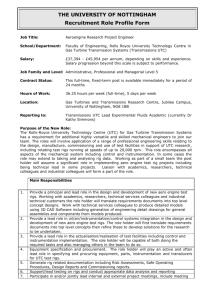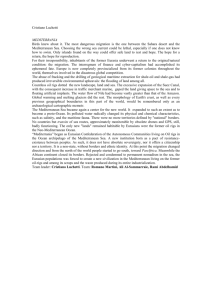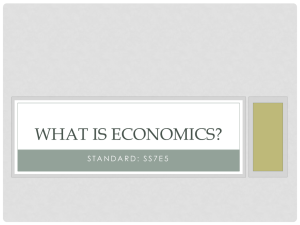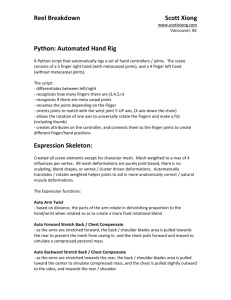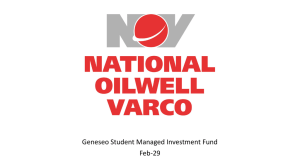Investor Presentation
advertisement
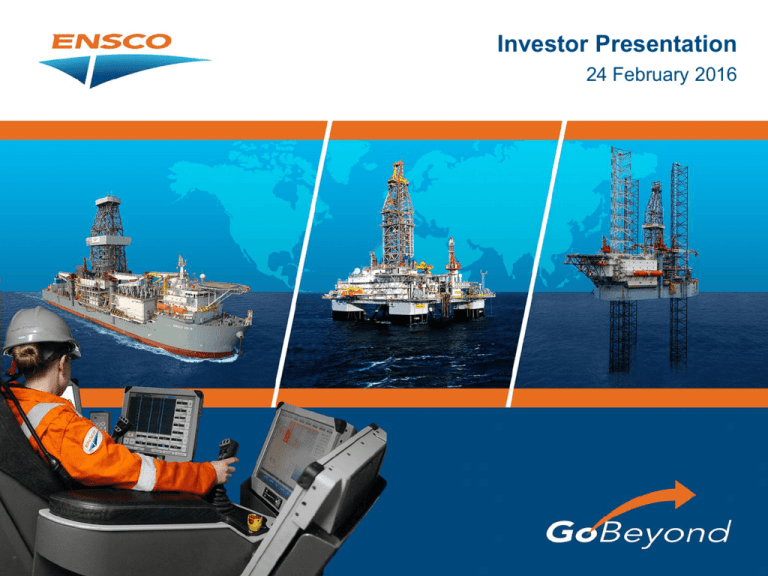
Investor Presentation 24 February 2016 1 Forward-Looking Statements Statements contained in this presentation that are not historical facts are forward-looking statements within the meaning of Section 27A of the Securities Act of 1933 and Section 21E of the Securities Exchange Act of 1934. Forward-looking statements include words or phrases such as “anticipate,” “believe,” “estimate,” “expect,” “intend,” “plan,” “project,” “could,” “may,” “might,” “should,” “will” and similar words and specifically include statements involving expected financial performance, day rates, contract drilling expenses and backlog; estimated rig availability; rig commitments; contract duration, status, terms and other contract commitments; new rig commitments and construction; rig upgrades; scheduled delivery dates for rigs; the timing of delivery, mobilization, contract commencement, relocation or other movement of rigs; benefits derived from expense management actions; estimated capital expenditures; rig retirements; rig stacking costs; and general market, business and industry conditions, trends and outlook. Such statements are subject to numerous risks, uncertainties and assumptions that may cause actual results to vary materially from those indicated, including commodity price fluctuations, customer demand, new rig supply, downtime and other risks associated with offshore rig operations, relocations, severe weather or hurricanes; changes in worldwide rig supply and demand, competition and technology; future levels of offshore drilling activity; governmental action, civil unrest and political and economic uncertainties; terrorism, piracy and military action; risks inherent to shipyard rig construction, repair, maintenance or enhancement; possible cancellation, suspension or termination of drilling contracts as a result of mechanical difficulties, performance, customer finances, the decline or the perceived risk of a further decline in oil and/or natural gas prices, or other reasons, including terminations for convenience (without cause); the outcome of litigation, legal proceedings, investigations or other claims or contract disputes; governmental regulatory, legislative and permitting requirements affecting drilling operations; our ability to attract and retain skilled personnel on commercially reasonable terms; environmental or other liabilities, risks or losses; debt restrictions that may limit our liquidity and flexibility; our ability to realize the expected benefits from our redomestication and actual contract commencement dates; cybersecurity risks and threats; and the occurrence or threat of epidemic or pandemic diseases or any governmental response to such occurrence or threat. In addition to the numerous factors described above, you should also carefully read and consider “Item 1A. Risk Factors” in Part I and “Item 7. Management’s Discussion and Analysis of Financial Condition and Results of Operations” in Part II of our most recent annual report on Form 10-K, as updated in our subsequent quarterly reports on Form 10-Q, which are available on the SEC’s website at www.sec.gov or on the Investor Relations section of our website at www.enscoplc.com. Each forward-looking statement speaks only as of the date of the particular statement, and we undertake no obligation to publicly update or revise any forward-looking statements, except as required by law. 2 4Q and Full-Year 2015 Results • $2.9 billion of non-cash impairments • New safety and operational performance records – 2015 TRIR of 0.32 – 4Q15 floater operational utilization of 96%; 99% for jackups • #1 in customer satisfaction for sixth consecutive year • ENSCO DS-8 commences initial five-year contract offshore Angola • ENSCO 8504 contracted in Indonesia • Reduced dividend to improve liquidity and capital management flexibility 3 Agenda • Current Market Conditions • Proactive Steps to Address Downturn • Outlook for Offshore Drilling – efficiency & cost improvements – attrition of older rigs • Maintain and Widen Leadership Position – #1 in customer satisfaction – innovation – efficient/cost-effective driller 4 Current Market Conditions $ billions Total Corporate Capex of Major & Large IOCs • Substantial reduction in E&Ps total capex since 2013 • Expect E&Ps total capex for 2016 to be ~30% lower year over year • Unprecedented decline in exploration spending • Lower rig utilization & day rates • The significant pullback in spending will affect supply in the future $350 $300 $292 $262 $250 $212 $200 $150 $100 $149 $50 $0 Source: IHS Upstream Competition Service Notes: Majors and Large IOCs peer group includes 15 international oil companies; estimates for 2015 and 2016 based on estimates and initial guidance, respectively. 5 Market Response • Drillers – cutting costs & stacking/retiring rigs – deferring rig deliveries – speculators canceling rig orders • Service companies – strategic combinations to invest in technological innovations and process improvements that increase efficiencies and drive out costs • Customers – – – – – reducing capex deferring projects early terminations/concessions for existing rig contracts re-engineering to increase efficiencies/reduce costs testing economics for future programs based on lower costs and streamlined project management 6 • Capital Management • Fleet Restructuring • Expense Management • Operational Excellence & Safety – innovation – process improvements Taking Decisive Steps To Be Resilient Through The Downturn 7 Proactive Capital Management • Accessed the debt markets – $1.25 billion offering in 3Q14 – $1.10 billion offering in 1Q15 to refinance 2016 maturities • Increased revolver to $2.25 billion and extended to 2019 • Reduced dividend twice to improve liquidity and capital management flexibility • Deferred delivery of ENSCO DS-10 to 1Q17, delaying ~$300 million in capex, and ENSCO 123 to 1Q18, delaying ~$200 million in capex • $1.3 billion of cash and short-term investments as of year-end 2015 8 Debt Maturity Profile $ millions $3,000 $2,700 $2,400 $2,100 $1,800 No debt maturities until 2Q19 Increased Revolving Credit Facility to $2.25B; extended to 2019 $2,250 $1,500 $1,500 $1,200 $1,025 $900 $900 $600 $500 $625 $700 $300 $300 $150 $0 2015 2016 2017 2018 2019 2020 2021 2022 2023 2024 2025 2027 2040 2044 9 Credit Ratings BBB+ BBB Investment Grade BBB BBB- BB+ BB B CCCNot Rated DO ESV NE RDC RIG Source: Standard & Poor’s Ratings Services credit ratings as of 24 February 2016 ATW PACD ORIG SDRL 10 Capital Expenditure Outlook $ millions $450 150 $450 50 50 25 275 2016E New rig construction $325 50 50 350 225 2017E Rig enhancements 2018E Minor upgrades and improvements Note: Estimates for 2016, 2017 and 2018; final capex estimates to be determined upon completion of annual budget process and subject to change based on rig contracting; new rig construction represents contractual commitments plus anticipated capex associated with rig construction; 2016 rig enhancements capex is specific to a mooring upgrade for an additional ENSCO 8500 Series rig, while 2017 and 2018 rig enhancements are estimates and not earmarked for any specific projects at this time; capex for minor upgrades and improvements are based on the currently active fleet. 11 Fleet Restructuring: Newbuild Deliveries 2012.75 2013.75 2016.75 2017.75 2018.75 2018 2019 2014 2014.75 2015 2015.75 2020 2019.75 2016 2017 2013 ENSCO DS-7 ENSCO 120 4 yrs with Total 2+ yrs with Nexen ENSCO 121 2 yrs w/ Wintershall ENSCO 122 2 yrs with NAM 3 yrs with NDC ENSCO 110 5 yrs with Total ENSCO DS-8 ENSCO DS-9 Delivered & Contracted 2 yrs on operating rate* Delivered and On Operating Rate ENSCO 140 Under Construction & Uncontracted ENSCO 141 ENSCO DS-10 ENSCO 123 Drillships Premium jackups *Note: Customer has terminated contract for its convenience. Per terms of contract for early termination, customer is required to make monthly payments for two years equal to the operating day rate of approximately $550,000, which may be partially defrayed should Ensco re-contract the rig within the next two years and/or mitigate certain costs during this time period while the rig is idle and without a contract. 12 Upgrades to Existing Floaters • Prior floater upgrades expected to benefit 2016 results – ENSCO 5004 – ENSCO 5006 • ENSCO 8503 mooring upgrade complete and under contract with Stone Energy to 3Q17 • ENSCO 8505 mooring upgrade complete and on contract with Marubeni to 1Q18 • 3rd ENSCO 8500 Series floater likely to receive mooring upgrade 13 Fleet Restructuring: Divestitures & Scrapping • 21 rigs sold since 2010 generating ~$675 million in proceeds – 7 rigs sold since September 2014 • 4 jackups sold for more than $200 million in proceeds during 3Q14, reducing exposure to Mexico jackup market • 3 floaters >30 years of age sold for scrap value • 12 rigs to be retired – 7 rigs in continuing operations – 6 jackups and 1 floater – 5 rigs in discontinued operations – 2 jackups and 3 floaters 14 Expense Management Actions 15% reduction in offshore unit labor costs + $57 million annual savings in onshore support costs • February 2015 – 9% unit labor cost decrease for offshore workers – 15% reduction of onshore positions • $27 million in annualized savings – full run-rate savings beginning 2Q15 • August 2015 – +6 ppt improvement in offshore unit labor cost savings to 15% compared to 2014 levels; full run-rate savings beginning 1Q16 – 14% incremental reduction of onshore positions • $30 million additional annualized savings from 2014 levels; full run-rate beginning 4Q15 • consolidated business unit reporting structure from five to three, centralizing certain functions and rationalizing office space 15 Proactive Rig Stacking • Stacking rigs without nearterm contracting opportunities reduces daily operating expenses • Up-front costs to preserve cold stacked rigs – $1 million for jackups – $5 million for semis • 8500 Series semis cold stacking process includes: Avg Daily Operating Expenses Warm Stack Cold Stack <$10k per day Drillship $40k per day Semi $32k per day <$10k per day Jackup $20k per day <$5k per day (ENSCO DS-1 & DS-2) – dehumidification – prevention of hull corrosion – key equipment preservation 16 Improved Expense Outlook Contract Drilling Expense 2Q15A 3Q15A 4Q15A 1Q16E $503 million $434 million $398 million $385 – $390 million Excl. $17 million provision for doubtful accounts related to ENSCO DS-5 drilling services contract Prior estimate of $415 - 420 million 17 Innovation During the Downturn Ensco Asset Management System • Proprietary asset management system – improve operational performance by increasing uptime – reducing maintenance costs – lower lifetime equipment costs • Leverages standardization 18 Excellent Safety Performance Total Recordable Incident Rate 1.2 1.0 0.8 0.6 0.4 0.2 0.0 • Record 2015 TRIR • Leading-edge safety management systems • Enhancing process safety to drive further improvements 2008 2009 2010 2011 2012 2013 2014 2015 Ensco Industry Note: IADC industry statistics are as of 3Q15. 19 Net Income Margin Largest Offshore Drillers 29% 25% 21% 19% 17% ESV SDRL NE RIG RDC 16% DO Source: FactSet; sum of trailing eight quarters of net income divided by sum of trailing eight quarters of revenue. FactSet's data is based on aggregation of information collected from industry equity research analysts and may not be based on GAAP reported financial data; Ensco, Seadrill, Noble and Transocean adjusted for extraordinary items such as gains and losses on asset disposals, legal settlements and early termination and arbitration fees. ESV proforma net income from continuing operations of $176 million, which excludes $2.7 billion impairment and corresponding tax impact used to calculate 4Q15 net income margin. ESV, NE, and DO financials as of 4Q15 earnings releases. SDRL, RIG, RDC financials as of 3Q15 earnings disclosures. 20 High Levels of Customer Satisfaction Rated #1 • Total Satisfaction • Safety & Environment • Performance & Reliability • Job Quality • Special Applications • Ultra-Deepwater Wells • Deepwater Wells • Harsh Environment Wells • Horizontal & Directional Wells • Shelf Wells • North Sea • Middle East • Asia & Pacific Rim 21 Outlook for Offshore E&P Key Points to Remember 1. Deepwater production is 7% of global supply 2. Offshore reserves are a critical part of major E&P portfolios 3. Excessive costs/inefficiencies crept into sector during the $100+ oil environment 4. Industry is proactively responding to commodity price pressures 5. Breakeven commodity prices for offshore programs are declining 6. Unprecedented decline in E&P exploration spending expected to create pent up demand and a future snapback in spending 22 Importance of Deepwater • Shell has stated that deepwater is a key driver of growth – “Our growth priorities follow two strategic themes: integrated gas and deepwater. These will provide our medium-term growth and we expect them to become core engines in the future.” - Jan. 2015 • Shell’s recent February 2016 acquisition of BG aligns with the company’s priorities in deepwater, particularly in Brazil – “Brazil is an absolutely outstanding upstream province … [and] at this moment is the most exciting part of the industry.” - Apr. 2015 – “The potential is absolutely gigantic – there is much more to come.” - Apr. 2015 23 Importance of Deepwater Other major E&Ps have made similar comments regarding the importance of deepwater projects to future growth – BP: “In order to deliver long-term growth, we will continue to maintain a disciplined investment approach into three distinctive classes of assets: deepwater, gas value chains and giant fields. We will continue to maintain a balanced portfolio of opportunities.” - Oct. 2015 – Chevron: “New supply will increasingly come from more complex and remote sources with higher full-cycle development costs [including] arctic, deepwater, heavy, sour and the like.” - Mar. 2015 – Total: “A new direction is being taken to carry out deep offshore operations in even deeper waters … and at greater distances for multiphase production transport … which is fully in line with the ambitious goals of [the company’s] exploration and production [business] and supports major technology-intensive assets such as Libra in Brazil.” - Apr. 2015 24 Customers Re-Engineering Projects • BP Mad Dog: Phase 2 – Cost estimates reduced to less than $10 billion from previous estimate of $22 billion – Project re-engineering through standardization and scope optimization, coupled with industry deflation, resulted in significantly less capital required to develop approximately 90% of resources • Shell Appomattox – 20% reduction in project costs from supply chain savings, design improvements, etc. • Total Block 32 – Capital expenditure estimate reduced by $4 billion to $16 billion – Optimized project design and contracting strategy • Statoil – “Standardization is the new innovation.” 25 Service Sector Response Recent strategic combinations/alliances among service companies to drive greater efficiencies and lower the breakeven commodity prices for projects: • Schlumberger/Cameron – strategic innovation, efficiencies and cost reductions in deepwater projects; driving down breakeven commodity price levels • GE Oil & Gas/McDermott – improve design/planning of offshore oil and gas field developments • OneSubsea/Subsea 7 – enhance project delivery, improve recovery and optimize the cost and efficiency of deepwater subsea developments • FMC Technologies/Technip – overhaul subsea field operations to drive efficiencies • Baker Hughes/Aker Solutions – develop technology for production solutions that will boost output, increase recovery rates and reduce costs for subsea fields • Schlumberger/OneSubsea/Helix – optimize the cost and efficiency of subsea well intervention systems 26 Jackup Market Dynamics • Shallow water well programs have lower breakeven commodity price points on average than deepwater projects – less complex drilling requirements, shallower water depths and greater access to existing infrastructure • More diverse customer base; shallow water demand a function of customer- and region-specific factors – increased rig demand in the Middle East from NOCs – leases requiring continued drilling in areas like North Sea and West Africa have stabilized demand as exploration capex has been reduced – well intervention now more economic in lower day rate environment – U.S. Gulf of Mexico and Asia Pacific markets are challenged due to capex reductions and uncontracted newbuild supply, respectively • Drillers with established operational and safety track records have an advantage in contracting rigs – zero newbuilds being built in China by speculators have been contracted 27 Global Marketed Rig Fleet Active Fleet Floaters Jackups Contracted 191 280 Idle/Other 66 105 Total 257 385 74% 73% Under Construction 50 29 / 43% by 113 69 / 60% by On Order / Planned 17 Total 67 115 49% 10% % Contracted Newbuilds % Contracted SETE Brasil 2 Speculators Source: IHS-ODS Petrodata as of February 2016; competitive marketed floaters and jackups (independent leg cantilever rigs); ‘contracted’ includes rigs currently under contract or with a future contract 28 Attrition of Older Floaters ~100 floaters could be retired by year-end 2017 if attrition continues at similar rates observed over the past 15 months Scrapped to Date 50 floaters scrapped since 3Q14 • 88% attrition for rigs >35 years of age historically – 27 rigs >35 years of age scrapped • 67% attrition for rigs 30-34 years of age historically – 12 rigs 30-35 years of age scrapped • 11 rigs <30 years of age scrapped – 8 rigs <20 yrs old scrapped Currently Idle ~35 floaters that are idle without follow-on work could be retired Expiring Contracts ~40 floaters with contracts expiring before YE17 without follow-on work could be retired • 25 rigs >35 years of age x 88% attrition rate ~22 scrap candidates • 24 rigs >35 years of age x 88% attrition rate ~21 scrap candidates • 16 rigs 30-34 years of age x 67% attrition rate ~11 scrap candidates • 24 rigs 30-34 years of age x 67% attrition rate ~16 scrap candidates • Floater utilization would improve to 75% from 67% if ~35 rigs were scrapped Source: IHS-ODS Petrodata as of February 2016; ‘retired’ includes scrapped rigs, announced scrapping and rigs converted to non-drilling units; utilization figures include non-marketed units 29 Newbuild Floater Order Book 8% 67 Total 5 Contracted 25% 17 SETE Brasil, Under Construction 41% 28 Uncontracted, Under Construction 12 SETE Brasil, On Order 5 Uncontracted, On Order 8% Source: IHS-ODS Petrodata as of February 2016; marketed competitive floaters 18% 30 Attrition of Older Jackups 100+ jackups could be retired as expiring contracts and survey costs lead to the removal of older rigs from drilling supply Retired to Date 15 competitive jackups retired since 3Q14 • 15 competitive jackups retired • Between 1Q09 and 2Q14, another 13 competitive jackups were retired with an average age of 30 years Currently Idle 72 competitive jackups >30 years of age idle • 19 competitive jackups >30 years old have been idle for at least one year • 22 competitive jackups >30 years old have been idle for six to 12 months • 31 competitive jackups >30 years old have been idle up to six months Source: IHS-ODS Petrodata as of February 2016; competitive jackups are independent leg cantilever rigs, ‘retired’ includes scrapped rigs, announced scrapping and rigs converted to nondrilling units; utilization figures include non-marketed units • Jackup utilization would improve to 77% from 65% if ~80 rigs were retired Expiring Contracts 76 jackups >30 years of age have contracts expiring before YE17 without follow-on work • ~50% of these rigs are estimated to require a major survey for recertification within one year of contract expiration • These surveys could require significant capital investment to meet classification requirements that may prompt more rig retirements 31 Newbuild Jackup Order Book 10% 115 Total 11 Contracted, Established Drillers 30% 35 Uncontracted, Established Drillers Zero rigs being built in China by speculators have been contracted 67 Uncontracted, Speculators 58% 2% 2 Uncontracted, On Order Source: IHS-ODS Petrodata as of February 2016; marketed competitive jackups (independent leg cantilever rigs) 32 Summary • We have taken proactive capital management, fleet restructuring and expense management decisions • We believe our liquidity and balance sheet position gives us resilience and options • We have invested in innovation and engineering to grow our leadership position for the future • The offshore drilling industry will be reconfigured by this downturn - newer entrants and companies with weaker balance sheets will struggle In a very challenged market we believe our liquidity and balance sheet provide resilience and options 33 34

